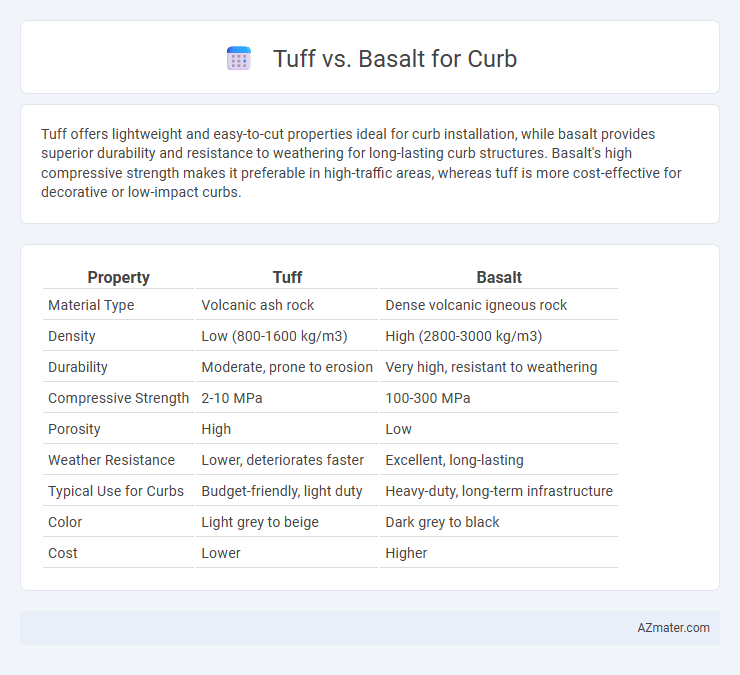Tuff offers lightweight and easy-to-cut properties ideal for curb installation, while basalt provides superior durability and resistance to weathering for long-lasting curb structures. Basalt's high compressive strength makes it preferable in high-traffic areas, whereas tuff is more cost-effective for decorative or low-impact curbs.
Table of Comparison
| Property | Tuff | Basalt |
|---|---|---|
| Material Type | Volcanic ash rock | Dense volcanic igneous rock |
| Density | Low (800-1600 kg/m3) | High (2800-3000 kg/m3) |
| Durability | Moderate, prone to erosion | Very high, resistant to weathering |
| Compressive Strength | 2-10 MPa | 100-300 MPa |
| Porosity | High | Low |
| Weather Resistance | Lower, deteriorates faster | Excellent, long-lasting |
| Typical Use for Curbs | Budget-friendly, light duty | Heavy-duty, long-term infrastructure |
| Color | Light grey to beige | Dark grey to black |
| Cost | Lower | Higher |
Introduction to Tuff and Basalt as Curb Materials
Tuff, a lightweight volcanic rock formed from compacted volcanic ash, offers excellent workability and moderate durability, making it suitable for ornamental curbs and light-traffic areas. Basalt, an igneous rock known for its dense, fine-grained structure, provides superior strength and resistance to weathering, ideal for high-traffic curb installations. Both materials vary in porosity and hardness, influencing their longevity and maintenance needs in urban infrastructure.
Geological Formation of Tuff and Basalt
Tuff is a volcanic rock formed from consolidated volcanic ash ejected during explosive eruptions, resulting in a lightweight, porous structure ideal for curbs requiring ease of handling and some insulation. Basalt originates from rapidly cooled lava flows, creating a dense, fine-grained igneous rock known for its exceptional durability and strength, making it suitable for high-traffic curb applications. The geological formation differences influence their physical properties, with tuff's vesicular texture contrasting basalt's compact crystalline structure.
Physical Properties: Tuff vs Basalt
Tuff exhibits lower density and compressive strength compared to basalt, making basalt significantly harder and more durable for curbs. Basalt's high resistance to abrasion and weathering ensures greater longevity in outdoor environments, whereas tuff's porous structure can lead to increased water absorption and reduced frost resistance. These physical properties make basalt the preferred choice for high-traffic curb applications where strength and durability are critical.
Durability and Weather Resistance Comparison
Tuff and basalt both offer strong durability for curbing, but basalt excels in wear resistance due to its denser, volcanic origin, making it less prone to chipping and cracking under heavy traffic. Tuff, while durable, is a softer volcanic rock with higher porosity, which can reduce its resistance to freeze-thaw cycles and prolonged exposure to moisture. Basalt's superior weather resistance ensures longer lifespan in harsh climates, making it the preferred choice for curb applications requiring maximum resilience.
Aesthetic Differences in Curb Appearance
Tuff exhibits a softer, volcanic texture with earthy tones ranging from light beige to warm brown, creating a natural and rustic curb appearance. Basalt offers a dense, fine-grained surface with dark gray to black hues, providing a sleek, modern, and uniform look for curbs. The choice between Tuff and Basalt significantly affects the curb's visual impact, with Tuff emphasizing organic warmth and Basalt delivering contemporary sophistication.
Installation and Workability
Tuff offers superior workability for curb installation due to its relatively softer texture, allowing easier cutting and shaping on-site. Basalt's hardness provides exceptional durability but requires specialized tools and increased labor effort during installation. Choosing between Tuff and Basalt depends on balancing installation efficiency with long-term wear resistance in curb construction.
Cost Analysis: Tuff vs Basalt for Curbs
Tuff offers a cost-effective option for curbs due to its lower extraction and processing expenses compared to basalt. Basalt, while more expensive upfront, provides superior durability and resistance to weathering, potentially reducing long-term maintenance costs. Evaluating the total lifecycle cost, tuff suits budget projects, whereas basalt justifies higher initial investment through enhanced longevity.
Environmental Impact of Each Material
Tuff offers a lower carbon footprint compared to basalt due to its lighter weight and less intensive quarrying process, reducing transportation emissions. Basalt, while more durable and dense, requires more energy in extraction and processing, leading to higher environmental impact. Both materials are natural and recyclable, but selecting tuff can contribute to more sustainable curb applications by minimizing resource consumption and habitat disruption.
Maintenance and Longevity
Basalt offers superior durability and requires minimal maintenance due to its dense, non-porous structure that resists weathering and wear. Tuff, being a softer volcanic rock, tends to be more porous and prone to erosion, necessitating more frequent upkeep such as sealing and cleaning. Over time, basalt curbs maintain their structural integrity and appearance longer than tuff, making basalt the preferred choice for long-lasting, low-maintenance curb applications.
Best Applications and Recommendations
Tuff is lightweight and porous, making it ideal for decorative curbs in low-traffic areas where aesthetic appeal and ease of installation are prioritized. Basalt offers superior durability and high compressive strength, suited for heavy-duty curbs in high-traffic zones requiring long-lasting performance and resistance to weathering. For commercial or industrial curb applications, basalt is recommended, while tuff is better suited for landscaping and residential projects with lighter load demands.

Infographic: Tuff vs Basalt for Curb
 azmater.com
azmater.com